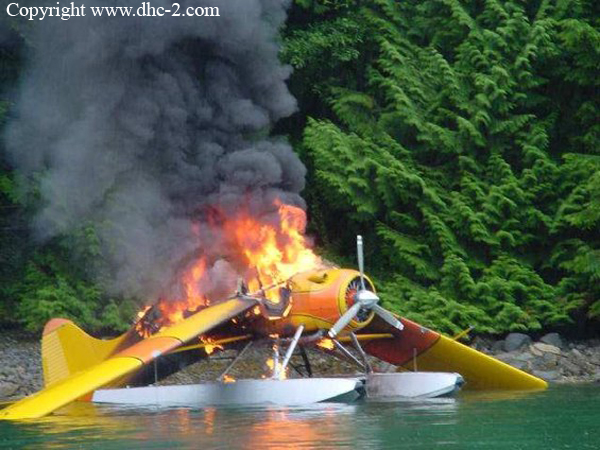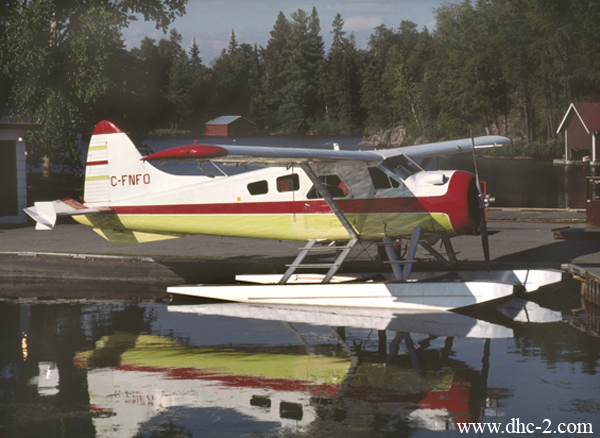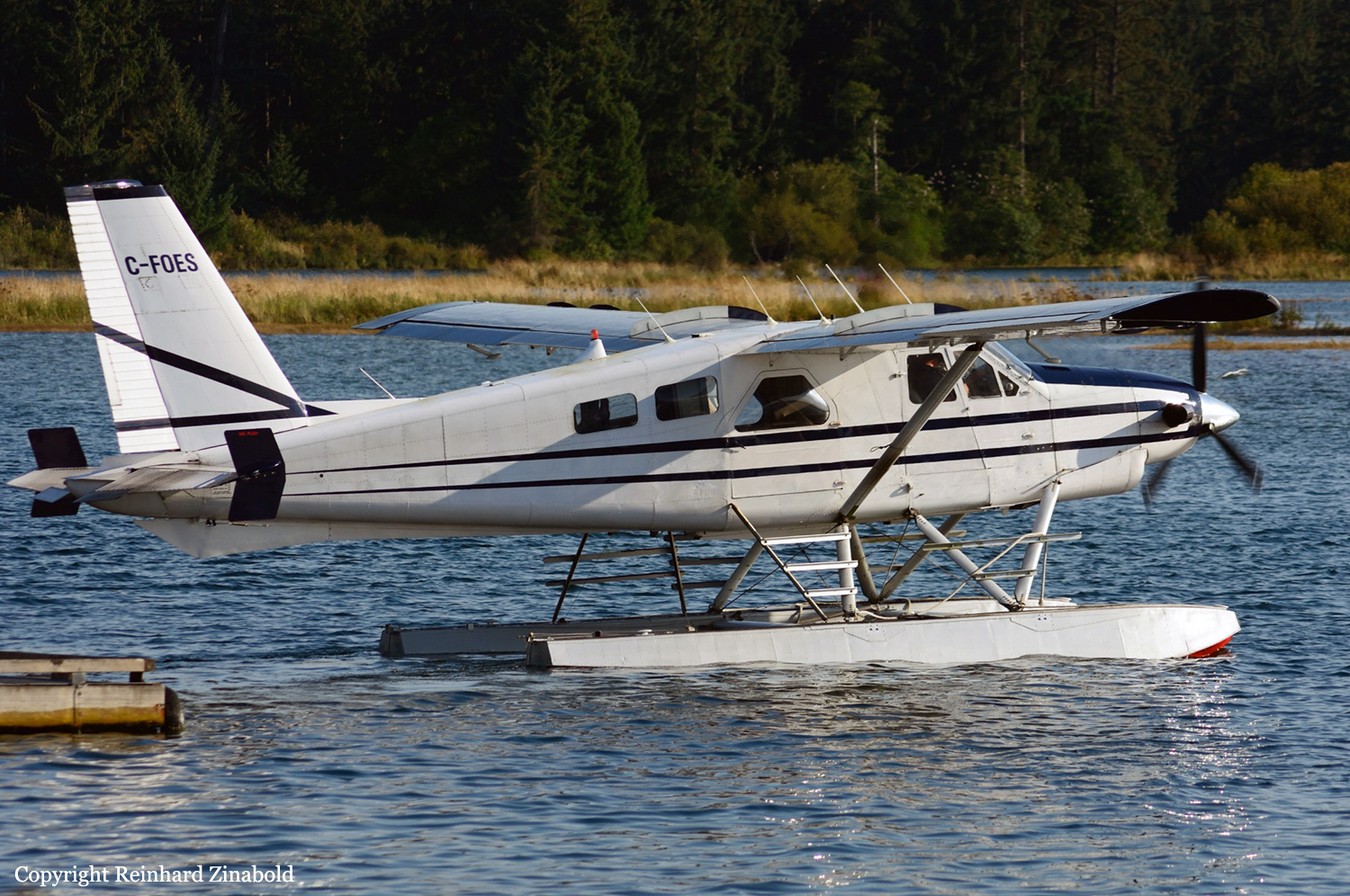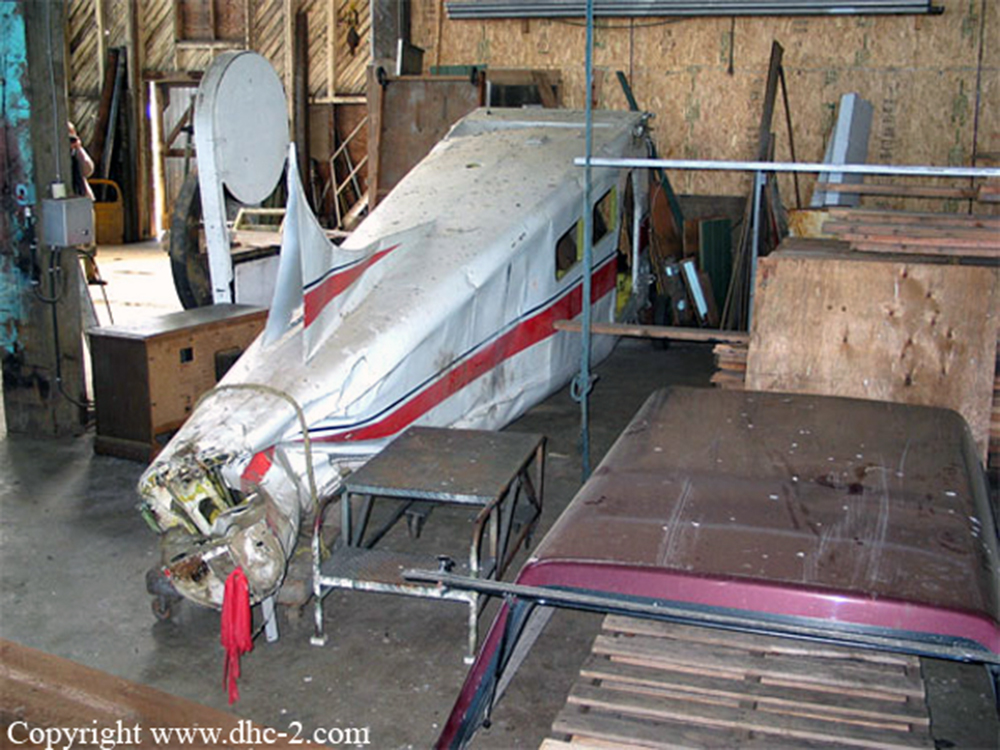Country
Ground fire of a De Havilland DHC-2 Beaver off Minstrel Island
Date & Time:
Aug 1, 2001
Registration:
C-GNWS
Survivors:
Yes
MSN:
1382
YOM:
1959
Crew on board:
1
Crew fatalities:
Pax on board:
3
Pax fatalities:
Other fatalities:
Total fatalities:
0
Circumstances:
he float-equipped aircraft had landed at Minstrel Island and was taxiing to the dock when the pilot of a company aircraft that was following C-GNWS to the dock radioed that he saw smoke coming from the lower right area of C-GNWS's engine cowling. The pilot of C-GNWS docked the aircraft, unloaded the three passengers and emptied a fire extinguisher onto the burning aircraft. The fire was not extinguished and the aircraft was pushed away from the dock where it burnt to the water.

Crash of a De Havilland DHC-2 Beaver near Nestor Falls: 1 killed
Date & Time:
Jul 7, 2001 at 1530 LT
Registration:
C-FNFO
Survivors:
No
Schedule:
Kakabikitchiwan Lake - Aremis Lake
MSN:
819
YOM:
1955
Crew on board:
1
Crew fatalities:
Pax on board:
0
Pax fatalities:
Other fatalities:
Total fatalities:
1
Captain / Total hours on type:
1300.00
Aircraft flight hours:
11843
Circumstances:
A de Havilland DHC-2 Beaver seaplane, registration C-FNFO, serial number 819, departed from Kakabikitchiwan Lake, Ontario, on a visual flight rules flight for Aremis Lake with only the pilot on board. Shortly after take-off, the aircraft was observed flying northbound at a very low altitude above Sabaskong Bay with the engine operating at a high power setting. The aircraft started to climb and bank to the left. The right wing struck the lower of two electrical wires strung across a channel between two islands. The aircraft was destroyed; the pilot sustained fatal injuries.
Probable cause:
Findings as to Causes and Contributing Factors:
1. The power line running overhead the channel was invisible, except at very short range, and was not marked to indicate its presence.
2. The pilot was flying at a very low altitude and likely did not see the power line.
Findings as to Risk:
1. The Standards Obstruction Markings Manual allows for discretion in deciding whether to assess obstructions, making it possible for some obstructions to not be assessed and, consequently, to not be marked.
1. The power line running overhead the channel was invisible, except at very short range, and was not marked to indicate its presence.
2. The pilot was flying at a very low altitude and likely did not see the power line.
Findings as to Risk:
1. The Standards Obstruction Markings Manual allows for discretion in deciding whether to assess obstructions, making it possible for some obstructions to not be assessed and, consequently, to not be marked.
Final Report:

Crash of a De Havilland DHC-2 Turbo Beaver near Clearwater
Date & Time:
Sep 22, 2000 at 1320 LT
Registration:
C-FOES
Survivors:
Yes
Schedule:
Clearwater - Clearwater
MSN:
1673
YOM:
1967
Crew on board:
1
Crew fatalities:
Pax on board:
1
Pax fatalities:
Other fatalities:
Total fatalities:
0
Captain / Total hours on type:
900.00
Circumstances:
The de Havilland DHC-2T Beaver floatplane, serial number 1673TB43, was engaged in aerial application of fish fry to several lakes near Clearwater, British Columbia. The pilot and one other person were on board. The aircraft took off from Clearwater at about 1230 Pacific daylight time (PDT) to begin a planned series of drops to nearby lakes. The aircraft had dropped fish in four lakes before proceeding to Broken Hook Lake.When the aircraft was on approach to the northwestern end of Broken Hook Lake, the pilot reportedly advanced the power lever, but the engine did not respond. At this time, the aircraft was about 100 feet above ground level and struck several treetops. Within seconds, the aircraft descended, struck the terrain, and crashed into trees. The two occupants were seriously injured, and the aircraft was destroyed. There was no fire. The accident occurred at 1320 PDT.
Probable cause:
Findings as to Causes and Contributing Factors:
1. The pilot did not avoid the trees that obstructed his immediate flight path on descent to the lake.
2. The damage to the aircraft from the tree-strike seriously compromised the pilot's ability to control the aircraft, to the point where continued flight was impossible.
3. The pilot and the passenger suffered serious injuries. It is highly likely that proper use of a passenger restraint system would have lessened the injuries to both persons.
Findings as to Risk:
1. Canadian regulations regarding the use of seats and seat restraint systems are not sufficiently clear about high-risk, aerial work operations, such as aerial application.
2. Transport Canada was not advised of the fish-dropping operations and was unaware that the passenger in the cabin was unrestrained during high-risk operations.
3. Canadian regulations do not require specific training in aerial application techniques, such as fish-dropping.
4. The installation of the fish-hopper equipment constituted an aircraft modification, which had not been approved by Transport Canada.
Other Findings:
1. The operator did not maintain a proper logbook.
1. The pilot did not avoid the trees that obstructed his immediate flight path on descent to the lake.
2. The damage to the aircraft from the tree-strike seriously compromised the pilot's ability to control the aircraft, to the point where continued flight was impossible.
3. The pilot and the passenger suffered serious injuries. It is highly likely that proper use of a passenger restraint system would have lessened the injuries to both persons.
Findings as to Risk:
1. Canadian regulations regarding the use of seats and seat restraint systems are not sufficiently clear about high-risk, aerial work operations, such as aerial application.
2. Transport Canada was not advised of the fish-dropping operations and was unaware that the passenger in the cabin was unrestrained during high-risk operations.
3. Canadian regulations do not require specific training in aerial application techniques, such as fish-dropping.
4. The installation of the fish-hopper equipment constituted an aircraft modification, which had not been approved by Transport Canada.
Other Findings:
1. The operator did not maintain a proper logbook.
Final Report:

Crash of a De Havilland DHC-2 Beaver in Hotnarko Lake: 3 killed
Date & Time:
Jun 19, 2000 at 1630 LT
Registration:
C-GAXE
Survivors:
Yes
Schedule:
Hotnarko Lake - Nimpo Lake
MSN:
841
YOM:
1955
Crew on board:
1
Crew fatalities:
Pax on board:
5
Pax fatalities:
Other fatalities:
Total fatalities:
3
Captain / Total hours on type:
150.00
Circumstances:
The de Havilland DHC-2 (Beaver) floatplane, serial number 841, departed Hotnarko Lake, British Columbia, at about 1630 Pacific daylight time. The pilot and six passengers were on board, with fishing gear and fish. Soon after take-off, the pilot entered a left turn. Before the turn was completed, the aircraft rolled, without command, further left to about 40 degrees of bank and the nose dropped. The aircraft did not respond to initial pilot inputs and continued in a left, diving turn toward the trees at the edge of the lake. The pilot tried to get the aircraft back onto the lake. The aircraft started to recover from the bank and the nose started to come up; however, the aircraft struck the lake surface before a level attitude could be regained. It broke apart on contact with the water and sank soon after. The pilot and four of the passengers managed to free themselves from the wreckage, but only three passengers and the pilot managed to swim to shore. One passenger slipped below the water surface before reaching the shore and drowned. Two passengers remained in the aircraft below the water surface, one secured by his seat belt, and drowned.
Probable cause:
Findings as to Causes and Contributing Factors:
1. When the pilot entered a turn, the combined effects of the increased g-forces, power reduction, the aircraft=s heavy weight, the aft CofG, retraction of the flaps, and the wind conditions resulted in
the aircraft stalling. The aircraft struck the lake surface before the pilot was able to re-establish a level-flight attitude.
2. The aircraft was operating in excess of 385 pounds above the maximum gross takeoff weight, and the CofG was about 2.7 inches aft of the aft limit. This loading configuration aggravated the stall characteristics of the aircraft.
3. The pilot reduced power and raised the flaps before the climb was complete, contrary to the Pilot Operating Handbook, thereby increasing the aircraft's stall speed.
Other Findings:
1. The shoulder harnesses worn by the pilot and the front passenger likely prevented serious head injuries.
2. The centre seat broke from its footings. This may have incapacitated the two passengers inside the aircraft or impeded their escape.
1. When the pilot entered a turn, the combined effects of the increased g-forces, power reduction, the aircraft=s heavy weight, the aft CofG, retraction of the flaps, and the wind conditions resulted in
the aircraft stalling. The aircraft struck the lake surface before the pilot was able to re-establish a level-flight attitude.
2. The aircraft was operating in excess of 385 pounds above the maximum gross takeoff weight, and the CofG was about 2.7 inches aft of the aft limit. This loading configuration aggravated the stall characteristics of the aircraft.
3. The pilot reduced power and raised the flaps before the climb was complete, contrary to the Pilot Operating Handbook, thereby increasing the aircraft's stall speed.
Other Findings:
1. The shoulder harnesses worn by the pilot and the front passenger likely prevented serious head injuries.
2. The centre seat broke from its footings. This may have incapacitated the two passengers inside the aircraft or impeded their escape.
Final Report:


Crash of a De Havilland DHC-2 Beaver near Lake Adonis: 3 killed
Date & Time:
Jan 13, 2000 at 1030 LT
Registration:
C-FIVA
Survivors:
Yes
Schedule:
Saint-Michel-des-Saints - La Pourvoirie des 100 Lacs - Lac Adonis
MSN:
515
YOM:
1953
Crew on board:
1
Crew fatalities:
Pax on board:
5
Pax fatalities:
Other fatalities:
Total fatalities:
3
Captain / Total hours on type:
3000.00
Aircraft flight hours:
26400
Circumstances:
The DHC-2 Mk. 1 skiplane, registration C-FIVA, serial number 515, with the pilot and five passengers on board, took off from the frozen surface of Lake Adonis, Quebec, on a pleasure flight under visual flight rules (VFR). The route had not been determined, but the flight was to last about 20 minutes. When the aircraft did not return, the search and rescue (SAR) service was advised. The aircraft was found crashed on a mountainside in a wooded area a little less than five km from its point of departure. The pilot and two passengers suffered fatal injuries. The other three passengers suffered serious injuries and hypothermia. The aircraft was destroyed by the force of the impact but did not catch fire. The five passenger, all from the same family, were originating from Marseille, France.
Probable cause:
Findings as to Causes and Contributing Factors:
1. The aircraft probably stalled with insufficient altitude for the pilot to execute a recovery.
2. The prevailing conditions were conducive to optical illusions associated with low-altitude flight over rising terrain.
3. The aircraft was not equipped with a stall warning system, nor was it required by regulation.
4. The pilot's decision to fly at low altitude and probably use cutback power for the climb did not allow for safe obstacle clearance.
5. The pre-flight safety briefing did not inform passengers where to find the survival equipment on board the aircraft. Consequently, they could not use the sleeping bags to protect themselves from exposure and thereby delay hypothermia.
6. Rescue was late because the mostly white aircraft blended into the snowy ground, making it difficult to locate, and the ELT antenna was broken, reducing the range of the signal. Consequently, the survivors' exposure time was increased.
Other Findings:
1. The pilot was certified and qualified for the flight.
2. The autopsy and toxicological test results revealed no indication that physiological factors affected the pilot's performance.
3. Records indicate that the aircraft was certified, equipped, and maintained in accordance with existing regulations and approved procedures.
4. The aircraft's weight and centre of gravity were within the limits specified in the aircraft fight manual.
5. There is no indication that there was an emergency situation or that the aircraft experienced problems prior to impact.
6. The ready-to-use weight and balance calculation form is not consistent with the standard. Transport Canada reported this irregularity in 1992, but no change was made in the form, which is still part of the company operations manual approved by Transport Canada on 23 October 1999.
7. The weather conditions were suitable for visual flight.
1. The aircraft probably stalled with insufficient altitude for the pilot to execute a recovery.
2. The prevailing conditions were conducive to optical illusions associated with low-altitude flight over rising terrain.
3. The aircraft was not equipped with a stall warning system, nor was it required by regulation.
4. The pilot's decision to fly at low altitude and probably use cutback power for the climb did not allow for safe obstacle clearance.
5. The pre-flight safety briefing did not inform passengers where to find the survival equipment on board the aircraft. Consequently, they could not use the sleeping bags to protect themselves from exposure and thereby delay hypothermia.
6. Rescue was late because the mostly white aircraft blended into the snowy ground, making it difficult to locate, and the ELT antenna was broken, reducing the range of the signal. Consequently, the survivors' exposure time was increased.
Other Findings:
1. The pilot was certified and qualified for the flight.
2. The autopsy and toxicological test results revealed no indication that physiological factors affected the pilot's performance.
3. Records indicate that the aircraft was certified, equipped, and maintained in accordance with existing regulations and approved procedures.
4. The aircraft's weight and centre of gravity were within the limits specified in the aircraft fight manual.
5. There is no indication that there was an emergency situation or that the aircraft experienced problems prior to impact.
6. The ready-to-use weight and balance calculation form is not consistent with the standard. Transport Canada reported this irregularity in 1992, but no change was made in the form, which is still part of the company operations manual approved by Transport Canada on 23 October 1999.
7. The weather conditions were suitable for visual flight.
Final Report:
Crash of a De Havilland DHC-2 Beaver near Washougal: 4 killed
Date & Time:
Nov 27, 1999 at 1455 LT
Registration:
N666XT
Survivors:
No
MSN:
826
YOM:
1955
Crew on board:
1
Crew fatalities:
Pax on board:
3
Pax fatalities:
Other fatalities:
Total fatalities:
4
Aircraft flight hours:
15540
Circumstances:
Witnesses reported that following takeoff from a river, the aircraft climbed to approximately 100 to 400 feet above the water, then initiated a left turn of approximately 45 degrees bank. The majority of the witnesses reported that after the aircraft had turned about 180 degrees, its nose abruptly dropped and it impacted the water. Witnesses did not report observing any evidence of problems with the aircraft before impact, and did not report hearing any abnormal engine sounds or sudden changes in engine pitch. Upon water impact, the aircraft went inverted and its cabin submerged. Efforts by witnesses to gain entry to the aircraft cabin to render assistance were unsuccessful due to aircraft damage. Rescue divers found all occupants deceased in the aircraft upon arrival, but were able to remove the two rear-seat victims without removing any passenger restraints. Autopsies disclosed that all four aircraft occupants had drowned. Investigators did not find any evidence of pre-impact aircraft or engine malfunctions during post-accident examinations of the wreckage, but did find that a cabin entry door was jammed shut due to impact damage, and that the range of travel of both pilot doors was restricted by damaged aircraft components.
Probable cause:
The pilot's failure to ensure attainment of adequate airspeed prior to initiating a steep turn at low altitude, resulting in an accelerated stall. A factor contributing to the occurrence of the accident was the aircraft's low altitude. Factors contributing to the severity of the accident included a water impact, and jammed/restricted doors due to impact damage resulting in degraded aircraft evacuation capability.
Final Report:


